Acknowledgement: This effective method was first evolved by the Water Conservation Laboratory in Arizona.
STAGNANT WATER
Stagnant water, or water which has become polluted, can be made drinkable and pure without equipment.
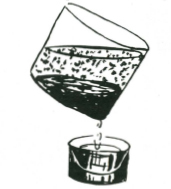
If time permits, such water can be filtered through a sieve of charcoal.
This will both clarify and to a large extent purify the water, but it is always safer to boil it before drinking.
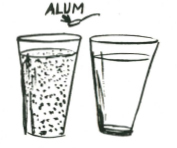
If the water is muddy, the clay particles in flotation in the water can be precipitated by a pinch of alum, which will flocculate and precipitate the particles and so clarify the water. This, however, requires at least 12 hours’ wait.
If no artificial means are available, the polluted or dirty water can be filtered by straining through closely woven garments such as a felt hat or a pair of thick drill trousers. The water, if polluted, can be sterilised by adding hot stones to the water in the filter. The water will soon boil and so made sterile and safe for drinking.

In areas where there is a likelihood of water being infected with bacteria, it is always advisable to boil before drinking or, failing this, to chlorinate the water with a pinch of chloride of lime.
CHAPTER 5
FIRE MAKING
The ability to obtain fire is essential in the bush. Fire can provide warmth, comfort, and protection. It is essential for the preparation of food, because heat in one form or another chemically affects the cells of plant foods, making some yield their nourishment, and others release their toxic elements.
Fire enables man to cook flesh and also to preserve it by smoking or drying. Fire is essential to make polluted water safe and drinkable.
The ability to obtain fire under any conditions, provided that combustible material is available, is one of the first essentials in out-of-door living.
The confidence which follows when one masters the skill of lighting fire with no equipment is remarkable.
Making fire by friction and other means is not easy, but when the skill has been mastered, the person acquiring the skill acquires greater knowledge of himself and greater confidence in his ability to overcome obstacles, both valuable characteristics in all avenues of life.
The ability to make fire under almost any condition is essential to the backwoodsman.
It may be important, too, that you know how to make fire that is almost smokeless, or fire that gives little or no flame. In war these two conditions can be of the greatest importance. It is also important to know how to make fire for signals, so that if you are lost, rescuers can be guided to you, and, of course you need fire to cook your food, fire to warm you, and fire to protect you.
THE CORRECT WAY TO LIGHT A FIRE WITH MATCHES
Even if you possess matches, lighting a fire in the bush may not be easy. The wood may be damp, it may be raining heavily, or there may be none of the usual aids, such as paper or kerosene. Therefore it is a good thing to learn how to light your fire with certainty under any condition.
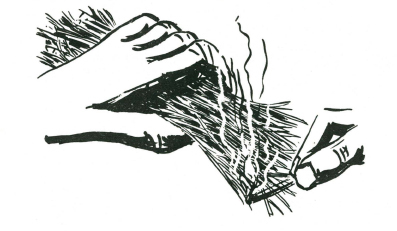
Unless the weather is very dry, and has been so for days on end, do not collect your kindling wood from the ground. It will certainly be damp, and in the morning, after heavy dew, wood picked from the ground will be far too wet to light. Acquire the habit of collecting the thin dead twigs, no thicker than a match, which you will find on almost every bush. Gather a big handful of these, and to start your fire hold the bundle in your hand, and apply the flame of your match to the twigs at the end farthest from your hand. They will catch fire easily, and you can turn the bundle in your hand until they are all well alight. Then lay the blazing bundle of twigs in your fireplace and proceed to feed other small twigs on top, gradually increasing the size until your fire is built to adequate proportions.
There will be occasions during very heavy rain when even the twigs are too sodden to catch alight easily. Then you must take a thick piece of wood, preferably from a branch which has not been lying on the ground, and with your knife, machete or tomahawk, split off the wet outer layer until only the dry wood inside remains. Shave this down in curls all round the sticks and make four to six such fire sticks. Hold these fire sticks by the butts in one hand and light the other end with your match. The dry curls will catch immediately, and the heat they generate in burning will be sufficient to during heavy rain you can light your fire with one match. In strong wind or during very heavy rain take your twigs, or fire sticks, inside your tent, and light them in the shelter so provided. Use your billy, carried on its side, to take the burning sticks to your fireplace.
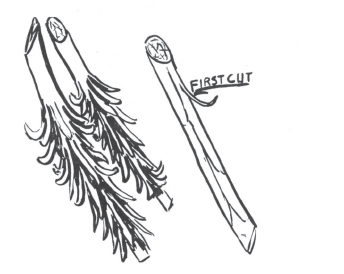
These fire sticks, shaved from the inner wood dry after heavy rain, will take flame immediately. Four to six will start a fire for you.
FIRE WITHOUT SMOKE, AND
FIRE WITHOUT FLAME
As outlined in the first paragraph, there may be occasions when you desire to have fire without disclosing your position either through smoke or flame.
Smoke is the result of incomplete combustion, and therefore by ensuring that combustion is quickly completed the fire will be nearly all flame, with practically no smoke. This is achieved by feeding the fire with small dry twigs which catch alight almost instantly. By feeding the fire continuously with twigs 1/8 inch thick there will be no ‘tell-tale’ blue smoke haze. If possible light your smokeless fire under a tree (but not against the trunk); the leaves and branches will completely disperse what tiny amount of smoke is given off by the burning twigs.
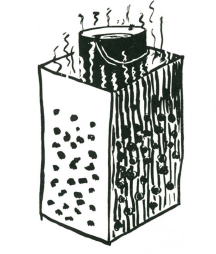
Fire without flame calls for the lighting of a small flame fire in the beginning, and then this is fed with charcoal, previously gathered from half-burnt stumps. It may be necessary to fan this continuously if there is no breeze. A charcoal fire needs a lot of air and, though it requires flame for starting, it will burn and give out great heat with a total absence of flame when well alight. An old kerosene tin or 4-gallon drum, pierced to allow plenty of air holes, makes a good brazier for a charcoal fire. By its use there is no visible flame. If a tin is not available, build a stone surround to your fireplace to hide the glow of your charcoal fire.
LIGHTING TWO FIRES WITH ONE MATCH AT DIFFERENT TIMES
To light two fires at different intervals of time with one match may appear to be impossible. But suppose you split one match? You then have two! and therein lies the secret of lighting two different fires with one match. There is a knack in splitting the match, be its stalk of wood, paper, or waxed fibre. There is also a knack in striking the split halves so that they will light, and there is also a knack in lighting your fire when the split match is aflame.
To split wooden matches, push the point of a pin or a sharp knife immediately below the head, and force down sharply–the head will split in two and the wood run off or split. You have two heads and enough wood left on one half to burn for a second or more–long enough to start tinder blazing.
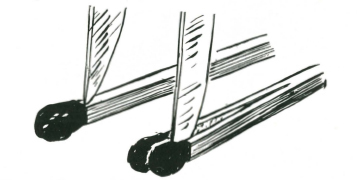
How to split a wooden match